As one of our newest problematic and prolific summer annual broadleaf weeds invading lawns throughout our area, Doveweed is a very aggressive and rapidly spreading weed with narrow soft low growing leaves that resembles grass. Doveweed is spreading rapidly in individual lawns and geographically…Read more »
As one of our newest problematic and prolific summer annual broadleaf weeds invading lawns throughout our area, Doveweed is a very aggressive and rapidly spreading weed with narrow soft low growing leaves that resembles grass. Doveweed is spreading rapidly in individual lawns and geographically. It has become one of the most problematic weeds to manage for turf managers and property owners. Small blue to purple flowers can be seen throughout the summer. Doveweed is a vegetative type broadleaf weed that spreads by stem nodes and by seed. Doveweed will overtake all turf types leaving bare areas in late fall/early winter when the weed ends its life cycle for the year.
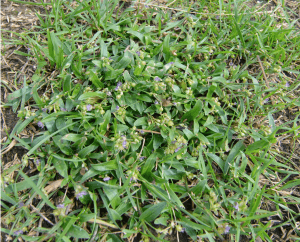
Doveweed with Purple Flower
Controlling Doveweed is very difficult. At this time, we do not have a proven post or pre-emergent herbicide available to effectively control Doveweed in Fescue turf. There are some pre and post-emergent herbicides available for Bermuda and Zoysia. However, these products are proving to offer limited success in most cases. Researchers at NC State University have been working with pre and post-emergent herbicides for a few years trying to find effective and reliable control options. Turf managers and property owners dealing with this prolific weed hope control options are found soon. Fairway Green has been using several different combinations to find the best control. We have heard some turf managers calling Doveweed the worst weed they have ever seen.
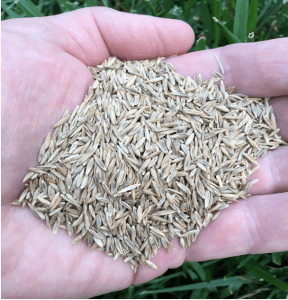
Certified TWCA “Southern Perfection”
Fall is the time to seed your fescue lawn in the Transitional Zone, not the spring. Seeding Tall fescue in the fall allows the seedlings and young plants time to develop before the warmer air and ground temperatures start in May. Fairway Green will begin fall seeding around the last week of August and complete seeding around the last week of October.
We offer either slit-seeding or aeration seeding based on the condition of your lawn. Our seed is handpicked for high performing varieties that are Brown Patch resistant as well as heat and drought tolerant. This special mixture is made for use in our transitional zone. Fairway Green’s seed mixture, “Southern Perfection”, has 0% weed and 0% other crop contamination. Southern Perfection is now WaterStar® qualified through the Turfgrass Water Conservation Alliance (TWCA).
If you are not willing to or unable to water, be patient. It is not uncommon to have seed germinate and develop throughout the winter and very early spring. Usually the turf has developed enough to use pre-emergence safely in late February and early March.
Remove leaves from the lawn as soon as possible. All turf types, especially your fescue, can be damaged if the leaves are allowed to stay on the lawn for extended periods. Blowing the leaves is preferred over raking if you have young fescue turf.
Be sure to adjust your mower to the highest setting when it is time to cut the young and mature turf.
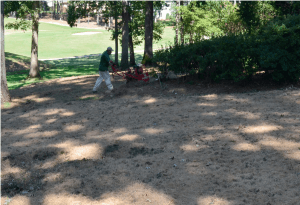 There is probably nothing wrong with your seed, as long as you used a quality turf type fescue. Fescue seed germination has been very slow this fall due to the extremely dry weather we have been experiencing. This has been exacerbated by dry breezy days that increase the drying rate of the soil and surrounding turf. Most seed, including grass seed, require a certain amount of constant moisture to start the germinating process. If the sufficient moisture level is not reached, germination will not occur. Quality grass seed can lay on the ground for a very long time and not germinate but still be viable and germinate when rain starts to fall.
There is probably nothing wrong with your seed, as long as you used a quality turf type fescue. Fescue seed germination has been very slow this fall due to the extremely dry weather we have been experiencing. This has been exacerbated by dry breezy days that increase the drying rate of the soil and surrounding turf. Most seed, including grass seed, require a certain amount of constant moisture to start the germinating process. If the sufficient moisture level is not reached, germination will not occur. Quality grass seed can lay on the ground for a very long time and not germinate but still be viable and germinate when rain starts to fall.
It will take much longer for your seed to germinate and develop with these conditions so it is best to be patient and understand this is normal and applying additional seed is often not required. In most cases it is putting new seed on top of seed that is perfectly fine.
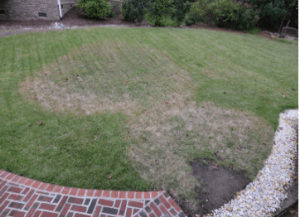
Large Patch Fungus in Zoysia
A reminder from the last newsletter. Late September starts the Large Patch fungus season on Zoysia, Bermuda, Centipede and St. Augustine. Fairway Green is seeing more cases of this disease every year in our area. Large Patch Fungus is a damaging disease on Zoysia, Bermuda, Centipede and St. Augustine turf in the fall and early spring. This disease is similar to Brown Patch Fungus on Fescue. Large Patch Fungus needs to be controlled with two applications of fungicide in the fall when ground temperatures are between 50 and 70 degrees. Damage occurs before you are aware you have it and is not visible until green-up in the spring. Preventative Fungicide in the fall and early spring is the only way to control this disease.

Close up of Poa annua (annual Bluegrass) in Bermuda
Now is the time to apply a pre-emergent for your warm season turf. A quality pre-emergent will help control annual grassy weeds like Poa annua (annual Bluegrass) and some winter annual broadleaf weeds.
We are still seeing grub activity and turf damage. White grubs are the larva of Scarab beetles. There are several beetles that produce the grubs we see while digging in our lawns and natural areas. Grubs in North Carolina are from Southern and Northern Chafer, Japanese, Asiatic, Green June and the May beetle. Grubs are identified by their cream, off white colored, body and off brown color hind part and head. Grubs have six legs and are from ¼ to 1½ inches. They are often seen in their C-shaped position in the soil.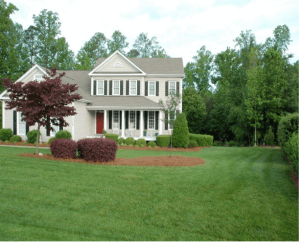
White grubs create damage in turf by eating the root system of the host plant. Turf damage is usually observed in late spring through fall with an off color, wilting appearance. Many times it is misdiagnosed as disease or heat or drought stress. The lawn may have a spongy almost loose feel to the soil under the turf. In severe cases, the turf may roll up when tugged on from the lack of roots holding it to the soil. Activity from birds, raccoons, skunks and moles could indicate a grub infestation. To determine the extent of grub activity and the need for control, you will need to use a spade to remove the upper 3 inches of soil in a 12” x 12” area. Cut back the turf sample to count the number of grubs and inspect root damage. If nine or more grubs are observed, take immediate action utilizing proper products for situation. All turf types are susceptible to grub feeding and damage.